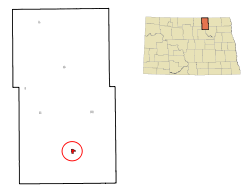Cando, North Dakota
| Cando, North Dakota | |
|---|---|
| City | |

Business district in Cando
|
|
| Motto: "Duck Hunting Capital Of North Dakota" | |
 Location of Cando, North Dakota |
|
| Coordinates: 48°29′19″N 99°12′16″W / 48.48861°N 99.20444°WCoordinates: 48°29′19″N 99°12′16″W / 48.48861°N 99.20444°W | |
| Country | United States |
| State | North Dakota |
| County | Towner |
| Area | |
| • Total | 0.63 sq mi (1.63 km2) |
| • Land | 0.63 sq mi (1.63 km2) |
| • Water | 0 sq mi (0 km2) |
| Elevation | 1,476 ft (450 m) |
| Population (2010) | |
| • Total | 1,115 |
| • Estimate (2015) | 1,122 |
| • Density | 1,769.8/sq mi (683.3/km2) |
| Time zone | Central (CST) (UTC-6) |
| • Summer (DST) | CDT (UTC-5) |
| ZIP code | 58324 |
| Area code(s) | 701 |
| FIPS code | 38-11860 |
| GNIS feature ID | 1028267 |
| Highways | US 281, ND 17 |
| Website | http://www.candond.com/ |
Cando (/ˈkænduː/ KAN-doo) is a city in Towner County, North Dakota, United States. It is the county seat of Towner County. The population was 1,115 at the 2010 census. Cando was founded in 1884.
Cando was founded in 1884 as the seat of the newly formed Towner County. It was named from the pioneers' "can do" spirit. The Great Northern Railway was extended to Cando in 1888.
Cando is located at 48°29′19″N 99°12′16″W / 48.488497°N 99.204542°W.
According to the United States Census Bureau, the city has a total area of 0.63 square miles (1.63 km2), all of it land.
As of the census of 2010, there were 1,115 people, 518 households, and 309 families residing in the city. The population density was 1,769.8 inhabitants per square mile (683.3/km2). There were 701 housing units at an average density of 1,112.7 per square mile (429.6/km2). The racial makeup of the city was 96.1% White, 0.2% African American, 2.3% Native American, 0.2% from other races, and 1.3% from two or more races. Hispanic or Latino of any race were 0.5% of the population.
...
Wikipedia
